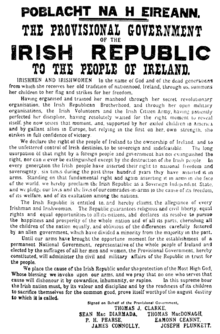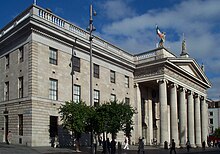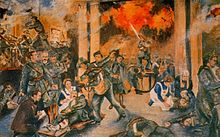Easter Rising
[18] In May 1915, Clarke and Mac Diarmada established a Military Council within the IRB, consisting of Pearse, Plunkett and Éamonn Ceannt – and soon themselves – to devise plans for a rising.Pearse (wearing the uniform of the Irish Volunteers) made a dramatic funeral oration, a rallying call to republicans, which ended with the words "Ireland unfree shall never be at peace".[58] British Naval Intelligence had been aware of the arms shipment, Casement's return, and the Easter date for the rising through radio messages between Germany and its embassy in the United States that were intercepted by the Royal Navy and deciphered in Room 40 of the Admiralty.Nathan proposed to raid Liberty Hall, headquarters of the Citizen Army, and Volunteer properties at Father Matthew Park and at Kimmage, but Wimborne insisted on wholesale arrests of the leaders.The British Army's chief intelligence officer, Major Ivon Price, fired on the rebels while the Under-Secretary for Ireland, Sir Matthew Nathan, helped shut the castle gates.[67] The rebels did not attempt to take some other key locations, notably Trinity College, in the heart of the city centre and defended by only a handful of armed unionist students.The British commander, Lowe, worked slowly, unsure of the size of the force he was up against, and with only 1,269 troops in the city when he arrived from the Curragh Camp in the early hours of Tuesday 25 April.[99][100] In the early hours of Tuesday, 120 British soldiers, with machine guns, occupied two buildings overlooking St Stephen's Green: the Shelbourne Hotel and United Services Club.[100][104] Their firepower was provided by field artillery which they positioned on the Northside of the city at Phibsborough and at Trinity College, and by the patrol vessel Helga, which sailed up the Liffey, having been summoned from the port at Kingstown.At 5:25 PM a dozen Volunteers, including Eamon Martin, Garry Holohan, Robert Beggs, Sean Cody, Dinny O'Callaghan, Charles Shelley, and Peadar Breslin, attempted to occupy Broadstone railway station on Church Street.[115] The British eventually took the position, which had not been reinforced by the nearby rebel garrison at Boland's Mills, on Thursday,[116] but the fighting there inflicted up to two-thirds of their casualties for the entire week for a cost of just four dead Volunteers.[118] The rebel position at the South Dublin Union (site of the present-day St. James's Hospital) and Marrowbone Lane, further west along the canal, also inflicted heavy losses on British troops.The British employed machine guns and attempted to avoid direct fire by using makeshift armoured trucks, and by mouse-holing through the inside walls of terraced houses to get near the rebel positions.[121] By the time of the rebel headquarters' surrender on Saturday, the South Staffordshire Regiment under Colonel Taylor had advanced only 150 yd (140 m) down the street at a cost of 11 dead and 28 wounded.[136] In the north, Volunteer companies were mobilised in County Tyrone at Coalisland (including 132 men from Belfast led by IRB President Dennis McCullough) and Carrickmore, under the leadership of Patrick McCartan.They made unsuccessful attacks on the RIC barracks at Clarinbridge and Oranmore, captured several officers, and bombed a bridge and railway line, before taking up position near Athenry.[154][155][156] In County Clare, Micheal Brennan marched with 100 Volunteers (from Meelick, Oatfield, and Cratloe) to the River Shannon on Easter Monday to await orders from the Rising leaders in Dublin, and weapons from the expected Casement shipment.On 29 April, the Royal Dublin Fusiliers under Company Quartermaster Sergeant Robert Flood shot dead two British officers and two Irish civilian employees of the Guinness Brewery after he decided they were rebels.[184] This radical transformation was recognised in the moment and had become a point of concern among British authorities; after Connolly's execution, the remaining death sentences were commuted to penal servitude.[6][185][186][187] Growing support for republicanism can be found as early as June 1916; imprisonment largely failed to deter militants – interned rebels would proceed to fight at higher rates than those who weren't – who thereafter quickly reorganised the movement.On the night of 28–29 April, British soldiers of the South Staffordshire Regiment, under Colonel Henry Taylor, had burst into houses on North King Street and killed fifteen male civilians whom they accused of being rebels.[204] The report, published on 26 June, was critical of the Dublin administration, saying that "Ireland for several years had been administered on the principle that it was safer and more expedient to leave the law in abeyance if collision with any faction of the Irish people could thereby be avoided."[208][g] Eyewitnesses compared the ruin of Dublin with the destruction of towns in Europe in the war: the physical damage, which included over ninety fires, was largely confined to Sackville Street.[214] The death and destruction, which resulted in disrupted trade, considerable looting and unemployment, contributed to the antagonism of the Volunteers, who were denounced as "murderers" and "starvers of the people" – the monetary consequences of the Rising were estimated to be at £2,500,000.[219] Drawing upon this support, and amidst the deluge of nationalist ephemera, the significantly popular Catholic Bulletin eulogised Volunteers killed in action and implored readers to donate; entertainment was offered as an extension of those intentions, targeting local sectors to great success.[226] Sinn Féin would become closely aligned with the Irish Republican Army, who sought to continue the IRB's ideals and waged armed conflict against British forces.[238] Revivalism of the parades has inspired significant public debate, although the centenary of the Rising, which featured the likes of ceremonies and memorials, was largely successful and praised for its sensitivity.[229][243][192][m] The "Pearsean combination of Catholicism, Gaelicism, and spiritual nationalism" would become dominant within republicanism, the ideas gaining a quasi-religiosity, whilst helping unify later strands thereof.[254] Literature surrounding the Rising was significant: MacDonagh, Plunkett, and Pearse were themselves poets, whose ideals were granted a spiritual dimension in their work; Arnold Bax, Francis Ledwidge, George William Russell and W. B. Yeats responded through verse that ranged from endorsement to elegies.[272][273] With the advent of a Provisional IRA ceasefire and the beginning of what became known as the Peace Process during the 1990s, the government's view of the Rising grew more positive and in 1996 an 80th anniversary commemoration at the Garden of Remembrance in Dublin was attended by the Taoiseach and leader of Fine Gael, John Bruton.




















Easter Rising (musical)Irish revolutionary periodO'Connell StreetNelson's PillarDublinGalwayWexfordIrish VolunteersIrish Republican BrotherhoodIrish Citizen ArmyFianna ÉireannCumann na mBanHibernian RiflesBritish ArmyRoyal Irish ConstabularyPatrick PearseJames ConnollyTom ClarkeSeán Mac DiarmadaJoseph PlunkettÉamonn CeanntThomas MacDonaghLord WimborneAugustine BirrellMatthew NathanLord FrenchLovick FriendJohn MaxwellWilliam LoweIrish revolutionaryperiodHome Rule CrisisCurragh mutinyHowth gun-runningLarne gun-runningConscription CrisisWar of Independence1920 Cork hunger strikeThe Troubles in Northern IrelandCreation of Northern IrelandPartition of IrelandAnglo-Irish TreatyIrish Civil War1923 Irish hunger strikesIrish Army MutinyIrish Parliamentary PartySinn FéinIrish Republican ArmyBlack and TansUlster Unionist PartyUlster Volunteer ForceUlster Special ConstabularyinsurrectionIrelandEaster WeekIrish republicansBritish rule in IrelandIrish RepublicFirst World Waruprising in Irelandrebellion of 1798Easter Mondayproclaimed the Irish RepublicgunboatEoin MacNeillmartial lawcourts martialphysical force republicanismDecember 1918 election in IrelandFirst Dáildeclared independenceLiberty HallKaiserActs of Union 1800Kingdom of Great BritainKingdom of IrelandUnited Kingdom of Great Britain and IrelandIrish ParliamentBritish ParliamentIrish nationalistsGreat FamineIrish uprisingRepeal AssociationHome Rule Leaguedisestablishment of the Church of IrelandLand LeagueIrish Home Rule movementCharles Stewart ParnellFirst Home Rule BillSecond Home Rule BillHouse of CommonsHouse of LordsGaelic Athletic AssociationGaelic Leaguecultural revivalW. B. YeatsAugusta, Lady GregoryArthur GriffithGaelicThird Home Rule BillH. H. AsquithIrish UnionistsSir Edward CarsonJames CraigUlster VolunteersleadershipDublin Lock-outNational VolunteersDublin CastleThomas Clarkedeclared warGermanyMichael Joseph O'RahillyBulmer Hobsonconscription in IrelandDenis McCulloughRoger CasementJohn DevoyIrish Brigadeexpeditionary forceRiver ShannonClan na GaelDolphin's BarnFenianJeremiah O'Donovan RossaGlasnevin CemeteryIreland unfree shall never be at peace